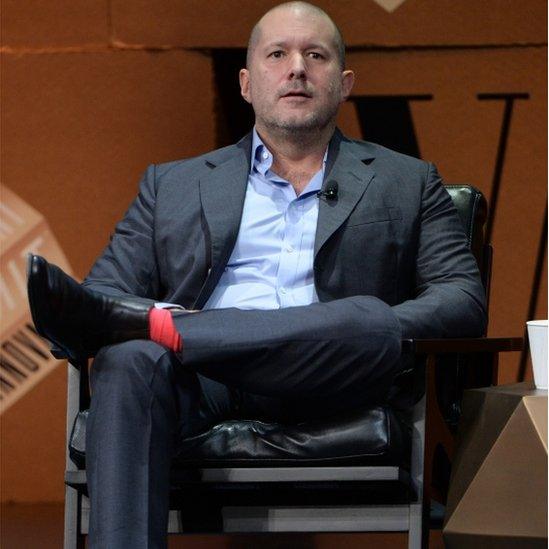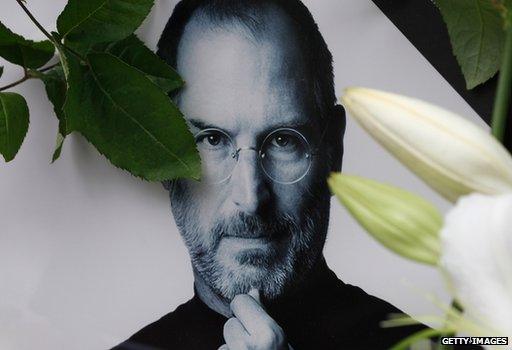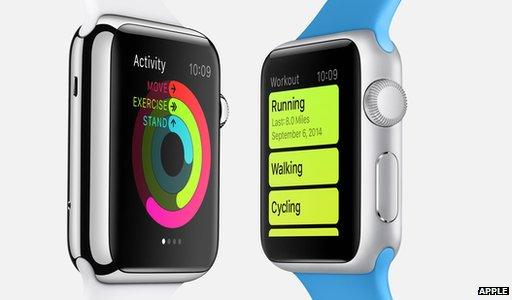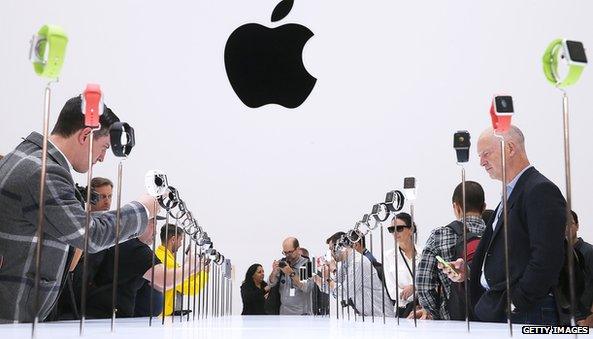Fashion challenge for Apple design guru Jony Ive
- Published

He's the world's most influential industrial designer - but now Jony Ive faces a supreme test. Can he turn Apple's smartwatch into another hit product without the backing of his mentor and partner Steve Jobs?
In recent weeks Sir Jonathan Ive - or Jony Ive as he is universally known - has been straying far from his usual habitat.
This shy, vaguely inarticulate man who spends most of his time locked in his design studio at Apple's Cupertino headquarters has been hanging out with fashionistas.
He has been pictured with Vogue editor Anna Wintour and fashion designer Karl Lagerfeld at an event in Paris. He has been quizzed on stage, wearing a suit rather than his habitual T-shirt, by the editor of Vanity Fair.
Why? Because the man who designed the iPod, the iPhone, the iPad - and every other Apple product of the past 15 years - is now venturing into unfamiliar territory where the approval of the fashion world will be vital.
Apple's Watch, which will go on sale in the new year, is the first new category the company has entered since the death of Steve Jobs, external, the first that Sir Jonathan has designed without the guiding hand of his mentor.
"Fashion is about identity," says Prof Jeremy Myerson, of the Royal College of Art, "so it's not surprising that the world of fashion and computing have come together.
"They're both about the expression of your own identity."

The Apple Watch has been made without the guiding hand of Steve Jobs
Prof Myerson, one of Britain's leading authorities on design, has watched and admired Jony Ive's progress since hearing the young designer's tutor at Newcastle Polytechnic describe him as a "once in a lifetime student".
He says he went to Apple in 1992 in the footsteps of other British industrial designers.
"They'd come out of a craft making background - they understood form, but they were very interested in electronic products."
But it was not until Steve Jobs returned from exile and spotted Sir Jonathan's talent in the late 1990s that the partnership that would transform Apple began.
"He was like an extra limb to Steve, they were incredibly close," says Clive Grinyer, who probably knows Sir Jonathan as well as anyone. Mr Grinyer asked Sir Jonathan to join his design consultancy, Tangerine, after seeing his student work.
And it was when Tangerine got some work with Apple that the young designer first travelled to California, then decided to stay.
Attention to detail
Clive Grinyer says the obsessive attention to detail, to simplicity, to making every aspect of a product inside and out look right was there right from the start - as was something else he brought to Apple.
"Everything he designed as a student was white, so I feel duty bound every time I buy an iPhone to buy a white one because that's the true heritage of Ive!"
Sir Jonathan's partnership with Steve Jobs is of course now over but, says Mr Grinyer: "He's a different person because of Jobs - Steve is just behind him on his shoulder in spirit."
What he has not had over the three years he and his team have worked on the Watch has been a partner to tell him whether the product is ready, something at which he has said Mr Jobs was brilliant.

The Apple Watch has fitness-tracking facilities
But he has persuaded his friend the Australian designer Marc Newson to join Apple, and Burberry's former chief executive Angela Ahrendts, now heading the retail operation, is on hand to give advice.
Apple's desire to woo the fashion world was clear when the Watch was first unveiled in September in Cupertino, where the crowd of adoring geeks was for the first time joined by many leading fashion journalists.
Rosie Mullender, of Cosmopolitan, was among them, and says the strategy has paid off. "So much of technology isn't female friendly and that needs to change. I was blown away by the Watch, there were so many female friendly designs - and that's something other smartwatches haven't achieved."
Jeremy Myerson says Sir Jonathan is a keen student of design history and will have been influenced by the likes of Dieter Rams of Braun.
But he sees the Watch as a different challenge from those Apple has previously faced. "In industrial design terms you've got so little to play with - the footprint for a designer to work his magic is so much smaller."
What is more, the competition from the traditional watchmakers is different from what Apple has faced before.
"When they were doing laptops, laptops were rubbish. There wasn't a 200-year-old Swiss laptop making industry. You've got to land some design ideas that are utterly compelling."

Apple Watch was unveiled in front of fashion journalists as well as technology writers
And despite her enthusiasm, Rosie Mullender sees one problem for a product whose top-end models could be priced at luxury levels.
"Fashion items like handbags can rise in value as they age, a Rolex watch becomes a classic - but technology is by its nature disposable."
It is hard to see Apple Watch version 1.0 being handed down from father to son.
But Clive Grinyer believes Apple can make a success of the Watch, and go on to become a fashion brand. "Will we see Apple jackets and clothing? I wouldn't be that surprised."
In the end, Apple's Watch will be judged on what it does as well as how it looks - and that means its user interface is key.
In the post-Jobs, external era, Sir Jonathan's role has expanded beyond hardware to control of the look and feel of Apple software.
Criticism
He has already come under criticism after hiccups with the latest mobile operating system, iOS 8, but if the Watch is buggy or fails to prove that it is really useful, the buck will stop with him.
The wooing of the fashion world will continue - a model wearing the Watch is on the cover of Vogue's China edition this month.
Steve Jobs famously encapsulated the philosophy he shared with Sir Jonathan when he said technology alone was not enough, it was "technology married with liberal arts, married with the humanities, that yields us the result that makes our heart sing".
But if the technology in the Apple Watch does not make hearts sing, no amount of coverage in the fashion magazines will make it a hit.